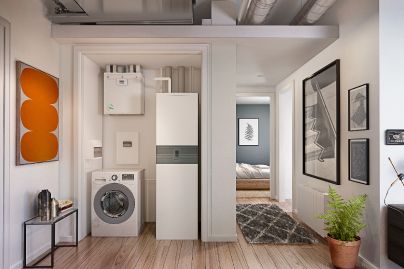Building Regulations in England & Parts L, F and O
With the transitional period now over, the updated 2022 Building Regulations Part L, Part F, and the new Part O, became legally enforceable for all new residential projects.
This is the biggest regulatory change the construction sector has seen in the last 40 years and a stepping stone in our transition away from fossil fuel systems toward decarbonised homes and the electrification of heat - and ultimately, the Future Homes Standard. This shift will impact the way we design buildings and specify technologies.
Have you decided which technologies to specify to achieve compliance for your next residential project?
The new English Building Regulations came into law on the 15th of June 2021. For projects with existing planning permission there is one year transitional arrangements period that applies on plot-by plot basis.
The updated Part L outlines the four compliance metrics for new developments: primary energy target, carbon emissions target, fabric energy efficiency target, and minimum standards for building fabric and building services.
The ventilation system choice under the updated Part F is linked to aritightness as we look to increase indoor air quality. New Part O offers modelling to help mitigate the risk of overheating in buildings.
We designed a simple guide to the changes to Part L and Part F, and the new Part O, and discuss what they may mean for your project.
Our range of HVAC solutions aim to provide future proof technologies to building projects over various sectors.
Request our presentation on Building Regulation changes that answer the most frequently asked questions.
Latest News
Our news section cover building regulations, what the changes to Part L, F, and the new Part of O entail, and what this means for HVAC specification.

How does the Zeroth Energy System address domestic hot water demand and reduce primary energy use in apartments?
Domestic hot water (DHW) is typically the dominant energy load in modern, well insulated buildings. Ambient loops, such as the Zeroth Energy System can significantly reduce the annual CO2 emissions and primary energy use of large residential properties in two ways:
Balancing the DHW demand and output
Heating water to the required temperature at the point of use
We will consider how the technology achieves these reductions and what the impact is on modern developments.

How can the Zeroth Energy System overcome the challenges of overheating in large residential developments?
The Zeroth Energy System uses an ambient loop designed to operate at 25oC. This reduces heat losses through the distribution network that could otherwise result in overheating occurring in corridors and communal spaces.

What is EN 14511?
EN 14511 sets out standardised performance and rating terms for air-conditioning units, heat pumps and liquid chilling packages that supply space heating or cooling. EN 14511 is used for a determination of the Coefficient of Performance (COP) that gauges the performance of a heat pump.











